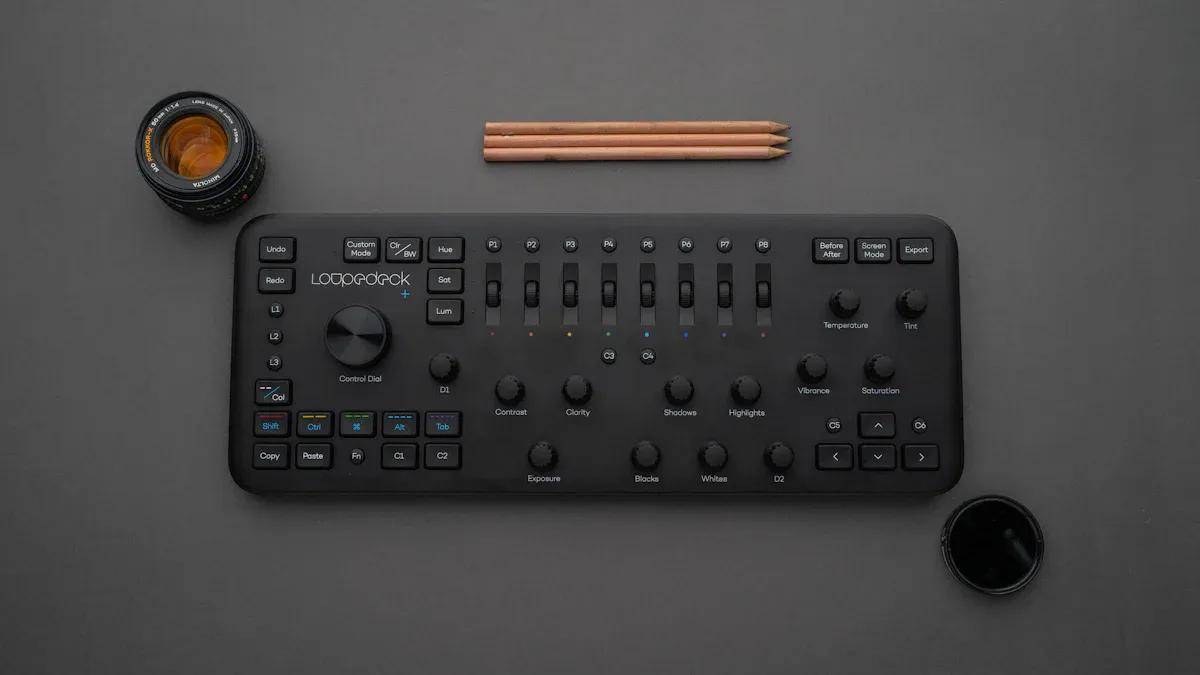
Finding the right braille keypad can feel overwhelming, but it doesn’t have to be. Whether you need a compact digital keypad for travel or an industrial braille keypad for work, the right choice depends on your lifestyle. Some even prefer an illuminated keypad for better visibility in low-light settings. What’s your priority?
Key Takeaways
- Decide why you need the braille keypad. Knowing if it’s for work or fun helps you choose better.
- Think about the size and how easy it is to carry. Pick a small one for travel or a bigger one for home. Make sure it works well for your needs.
- Try out the keypad to feel how it responds. A good keypad makes typing easier and more comfortable.
Understanding Your Needs
Define Your Primary Purpose
Start by asking yourself, "Why do I need a braille keypad?" Your answer will guide your decision. If you’re using it for work, you might need a model with advanced features like shortcut keys or navigation tools. For casual use, a simpler keypad could be enough. Think about whether you’ll use it for writing, reading, or both. Knowing your primary purpose helps you focus on keypads that meet your specific needs.
Evaluate Portability and Size Preferences
Do you plan to carry your braille keypad everywhere? If so, portability matters. Compact and lightweight models are great for travel or commuting. On the other hand, if you’ll mostly use it at home or in an office, a larger keypad with more features might be a better fit. Consider how much space you have in your bag or workspace. A portable keypad can make your life easier, but it’s important to balance size with functionality.
Consider Your Experience with Braille Technology
Are you new to braille technology, or do you already have experience? If you’re a beginner, look for a keypad with a simple layout and clear instructions. Advanced users might prefer models with customizable options and additional features. Your comfort level with technology plays a big role in how quickly you’ll adapt to a new device. Don’t hesitate to choose something that matches your skill level.
Key Features of a Braille Keypad

Importance of Tactile Feedback
Tactile feedback is one of the most important aspects of a braille keypad. You want to feel confident when pressing each key, knowing it responds accurately. A keypad with well-defined, responsive keys can make typing smoother and more enjoyable. If the keys feel too soft or unresponsive, it might slow you down or lead to errors. Look for a keypad that offers a satisfying "click" or noticeable texture when pressed. This feature ensures you can type efficiently, even without looking at the device.
Tip: Test the tactile feedback in person if possible. Everyone has different preferences, so finding what feels right for you is key.
Battery Life and Charging Options
Battery life can make or break your experience with a braille keypad. A long-lasting battery means fewer interruptions, especially if you’re using it on the go. Some keypads offer rechargeable batteries, while others rely on replaceable ones. Think about your daily routine. Do you have time to charge your device regularly, or would you prefer a model that lasts for days on a single charge? Also, check the charging options. USB-C is becoming the standard and charges faster than older ports.
Additional Functionalities (e.g., Shortcut Keys, Navigation)
Modern braille keypads often come with extra features to make your life easier. Shortcut keys can save time by letting you perform common tasks with a single press. Navigation buttons are another handy addition, especially if you use your keypad for reading or browsing. Some models even include programmable keys, so you can customize them to suit your workflow. These features might not seem essential at first, but they can significantly boost your productivity.
Note: While extra functionalities are great, don’t let them distract you from the basics. A reliable, easy-to-use keypad should always come first.
Compatibility and Connectivity
Ensuring Device Compatibility
Before buying a braille keypad, check if it works with your devices. Some keypads are designed for specific operating systems like Windows, macOS, or Android. Others might be universal. Look at the product specifications to confirm compatibility. If you use screen readers or other accessibility tools, make sure the keypad supports them. This step saves you from frustration later.
Tip: If you’re unsure, contact the manufacturer or read user reviews to see how well the keypad works with your device.
Choosing Between Wired and Wireless Options
Deciding between wired and wireless depends on your lifestyle. Wired keypads are reliable and don’t need charging. They’re great if you work at a desk most of the time. Wireless models, on the other hand, offer freedom of movement. You can use them anywhere without worrying about tangled cables. However, they rely on batteries or charging, so keep that in mind.
Exploring Bluetooth and USB Connectivity
Most modern braille keypads offer Bluetooth and USB connectivity. Bluetooth is perfect for wireless use. It lets you connect to multiple devices without plugging in. USB connections are faster and more stable. They’re ideal for tasks that require precision, like typing long documents. Some keypads even offer both options, giving you flexibility.
Note: If you choose Bluetooth, check the range and pairing process. A smooth connection makes all the difference.
Budget Considerations
Setting a Realistic Budget
Before you start shopping, think about how much you’re willing to spend. A braille keypad can range from affordable to premium, depending on its features. Ask yourself what’s essential and what you can live without. If you only need basic functionality, you don’t have to break the bank. On the other hand, if you’re looking for advanced features like Bluetooth connectivity or programmable keys, you might need to invest a bit more. Setting a clear budget upfront helps you avoid overspending and narrows down your options.
Tip: Make a list of must-have features and compare prices online to get a sense of what fits your budget.
Balancing Cost with Quality
It’s tempting to go for the cheapest option, but that might not always be the best choice. A low-cost keypad could lack durability or essential features. Instead, focus on finding a balance between cost and quality. Look for keypads made by trusted brands with good reviews. Spending a little more on a reliable device can save you money in the long run. You’ll avoid frequent repairs or replacements, which can add up over time.
Exploring Subsidy or Financing Options
If the cost feels overwhelming, don’t worry. Many organizations offer subsidies or financial assistance for accessibility tools. Check with local disability support groups or government programs to see if you qualify. Some retailers also provide financing options, allowing you to pay in installments. These resources can make owning a high-quality braille keypad more affordable and accessible.
Note: Always read the terms and conditions of financing plans to avoid hidden fees.
Researching Reviews and Recommendations
Identifying Trusted Brands
Start by looking for brands known for their quality and reliability. Trusted companies often have a history of producing durable and user-friendly braille keypads. You can check their websites to learn more about their products and values. Some brands even specialize in accessibility tools, which means they understand your needs better. A quick online search can help you identify the top names in the market. Stick with brands that have a good reputation and positive feedback from users.
Reading User Reviews and Testimonials
User reviews are a goldmine of information. They give you real-world insights into how a braille keypad performs. Look for reviews that mention the features you care about, like tactile feedback or battery life. Pay attention to both positive and negative comments. This helps you get a balanced view of the product. Testimonials from other users can also highlight any potential issues, so you know what to expect. Websites like Amazon or specialized forums are great places to start.
Tip: Don’t just read the highest-rated reviews. Check the mid-range ones too. They often provide the most honest feedback.
Seeking Advice from Accessibility Experts
Accessibility experts can offer valuable guidance. They understand the challenges you face and can recommend keypads that suit your needs. Reach out to local organizations or online communities focused on accessibility. Many experts are happy to share their experiences and tips. You can also attend events or workshops where you can try out different devices. Their advice can save you time and help you make a confident choice.
Testing a Braille Keypad Before Purchase

Trying Out Keypads in Person
Whenever possible, try out a braille keypad in person before buying it. This hands-on experience lets you feel the tactile feedback, test the layout, and see if it fits your needs. Visit local stores or accessibility centers that carry braille devices. Some organizations even host events where you can explore different models. Pay attention to how comfortable the keys feel under your fingers. Does the keypad respond the way you expect? These small details can make a big difference in your daily use.
Tip: Bring your device along to test compatibility on the spot. This ensures the keypad works seamlessly with your setup.
Understanding Return Policies
Even after testing, you might find that the keypad doesn’t meet your expectations. That’s why it’s important to understand the return policy before making a purchase. Check if the store or manufacturer offers a trial period or a money-back guarantee. Some policies allow you to return the product within a specific timeframe, no questions asked. Knowing this upfront gives you peace of mind and flexibility.
Note: Keep the original packaging and receipt. Many return policies require these for a full refund.
Exploring Demo or Trial Options
If you can’t test a keypad in person, look for demo or trial options. Many manufacturers and retailers offer short-term trials so you can use the device at home. Some even provide virtual demos to showcase the features. These options let you explore the keypad’s functionality without committing right away. Take advantage of these opportunities to ensure the keypad aligns with your needs.
Reminder: Ask about any fees or conditions tied to demo programs. This helps you avoid unexpected costs.
Choosing the right braille keypad doesn’t have to be complicated. Focus on understanding your needs, prioritizing essential features, and ensuring compatibility with your devices. Always test a keypad when possible and seek advice from trusted sources. The best choice is one that fits your unique requirements and makes your daily tasks easier and more productive.
FAQ
How do I know if a braille keypad is right for me?
Test it in person if possible. Check tactile feedback, compatibility, and comfort. If testing isn’t an option, read reviews or try demo programs.
Tip: Always prioritize your specific needs over extra features.
Can I use a braille keypad with multiple devices?
Yes, many keypads support multiple devices through Bluetooth or USB. Check the product specifications to confirm compatibility with your operating systems and accessibility tools.
Are expensive braille keypads worth it?
Not always. Higher prices often mean more features, but you should focus on quality and your needs. A mid-range keypad can offer excellent performance without breaking the bank.
Note: Trusted brands often provide better durability and support.


